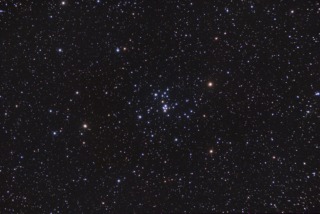
- Constellation: Auriga
- Right Ascension: 06h 48m 17.(0)s
- Declination: +41° 04′ 4(2)″
- Distance: 1,722 ly
NGC 2281 is a small bright open cluster located in Auriga.
- Details
- Category: Open Clusters
- Telescope: Explore Scientific 127 Refractor
- Camera: ZWO 2600 MM
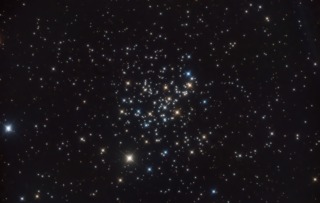
- Constellation: Cancer
- Right Ascension: 08h 51.3m
- Declination: +11° 49′
- Distance: 2,800 ly
Messier 67 is an open cluster located in the constellation of Cancer. It contains an estimated 500+ stars and is though to be some 4 billion years old.
- Details
- Category: Open Clusters
- Telescope: GSO RC10
- Camera: ZWO 2600 MM
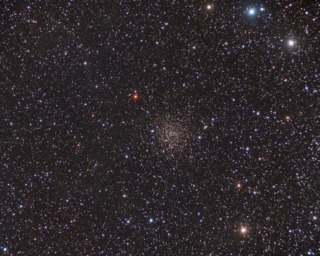
- Constellation: Lyra
- Right Ascension: 19h 20m 53s
- Declination: +37° 46.3′
- Distance: 13,300 ly
NGC 6791 is an interesting open cluster in Lyra, containing thousands of stars, its one of the older clusters known at 8 billion years. Most clusters tend to disperse over the millennia due to gravitational influences. In addition the stars are metal rich that is to be expected for an old cluster. Old clusters tend to be metal poor in their composition as it usually takes several star birth, death cycles to build up metals. That makes it one of the most studied open clusters.
The bright reddish-orange star above and left of the cluster is U Lyr, a red giant carbon star.
- Details
- Category: Open Clusters
- Telescope: Explore Scientific 127 Refractor
- Camera: ZWO 2600 MM
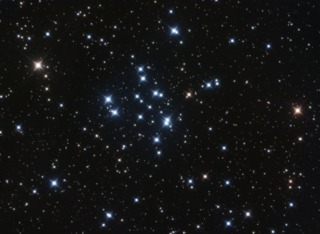
One classification of open clusters is the Trumpler classification. It consists of 3 parameters, the first is the degree of concentration.
I - Detached clusters with strong central concentration.
II - Detached clusters with little central concentration.
III - Detached cluster with no noticeable concentration.
IV - Clusters not well detached, but has a strong field concentration.
The second parameter is the range of brightness.
1 - Most of the cluster stars are nearly the same apparent brightness.
2 - A medium range of brightness between the stars in the cluster.
3 - Cluster is composed of bright and faint stars.
The last parameter categorizes the number of stars in the cluster.
p - Poor clusters with less than 50 stars.
m - Medium rich cluster with 50-100 stars.
r - Rich clusters with over 100 stars.
If the cluster any type of nebulosity, the letter "n" is added to the last parameter.
First up is Messier 34, located in the constellation of Perseus. Consisting of over 100 stars, in a space of a diameter of 14 light years. It is some 1,500 light years distance and shines at an apparent magnitude of 5.5 at an estimated age of 200 million years.
- Details
- Category: Open Clusters
Read more: Trio of Messier Open Clusters
- Telescope: GSO RC10
- Camera: ZWO 2600 MM
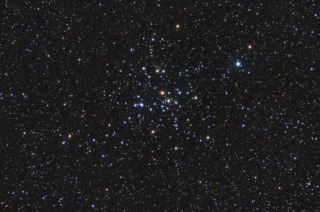
- Constellation: Canis Major
- Right Ascension: 06h 46.0m
- Declination: −20° 46′
- Distance: 2,300 ly
Messier 41 is an open cluster located in Canis Major near Sirius. The cluster contains some 100 members in a diameter of 25 light years. Estimated age of the cluster is around 200 million years. It is expected to remain as a cluster for 500 million years before dispersing. Brightest of the stars is an orange giant near the cent of the cluster. K3 type star, it has a magnitude of 6.3 and is 700 times more luminous than our Sun.
- Details
- Category: Open Clusters
- Telescope: Explore Scientific 127 Refractor
- Camera: ZWO 2600 MM
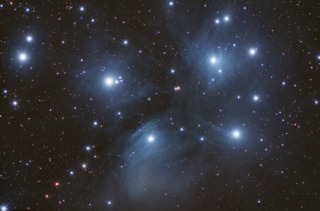
- Constellation: Taurus
- Right Ascension: 03h 47m 24s
- Declination: +24° 07′ 00″
- Distance: 444 ly
Messier 45, one of the more famous open clusters. Often called the Pleiades or the Seven Sisters, with the name Pleiades coming from Greek mythology. The cluster has been known since ancient times, and can be seen as a grouping of 6-7 stars, so it was interesting that Charles Messier included it in his catalog of objects that are not a comet, but could be mistaken for one.
The cluster is surrounded by a reflection nebula that the group is currently passing through, and not related to its original birth in a compact nebula. The cluster consist of at least 1,000 stars located in a radius of 8 light years. The cluster is dominated by hot blue luminous stars, but also contains many brown dwarfs that are not massive enough to initiate nuclear fusion. The estimated age of the cluster is around 100 million years, and its expected to take 250 million years to disperse due to gravitational interactions.
- Details
- Category: Open Clusters
- Telescope: Explore Scientific 127 Refractor
- Camera: ZWO 2600 MM